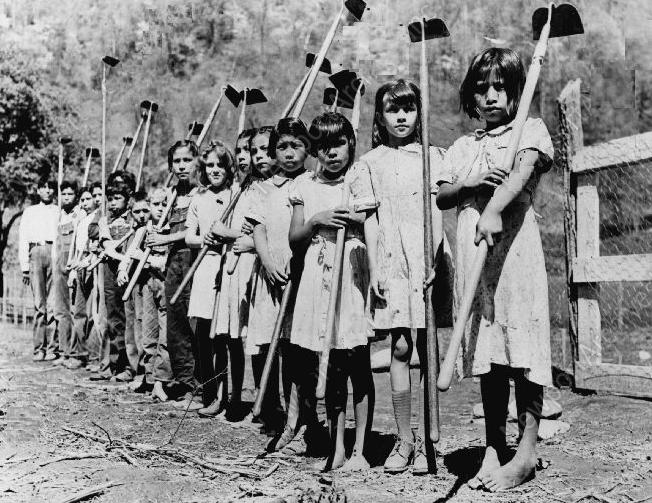
America World War II Home Front: Ethnicity--Native Americans

Figure 1.-- Despite a history of mistreatment, no other American ethnic group came to the country's defense with more unanimity and fierce patriotism than Native Americans. An Army historian writes, "The Japanese attack on Pearl Harbor seemed to waken an ancestral warrior spirit in many Native Americans." And the women and children that stayed home supported their men as best they could. Here Native American children on an unidentified reservation are helping to grow food during 1943. The caption seems rather insensative given the Native American contribution to the war effort. "Braves on Warpath .. Indian Women Carry On: On various reservations throughout the country American Indian women and children are working harder than ever they have worked before to keep the home fires burning and to do a bit for the war effort whole their men folk are on the warpath against the Axis. The women and children cultivate the land and raise crops and live stock, mostly sheep and goats which provide them with meat, milk, and clothing, and in general have taken over the tasks formerly performed by their absent braves."
|
|
Native Americans would seem to be the least sucessful group in the American ethnic melting pot. There is no doubt that the Native Americans were abused and taken advantage of from the time that the English bgan establishing colonies along the Eastern Seabord. Conflict was inevitable given that ultimately there would be a conflict over the land. The United States policy toward Native Americans was first to force them west and ultimaely on to reservations. The choice of marginal land for the reservations affected the prospects of the various Native American people. In modern times, the Native American people have not been forced to live on reservtions, but many chose to do so. And the results in economic terms has been abject failure. At the same time, efforts to remove Native American children in Bureau of Indian Affairs boarding schools have been roundly criticised as cruel and inhumane. One author describes the 'the horror of Native American boarding schools'. While such efforts certainly can be criticized, the problem posed by assimilating a stone age people into modern life is commonly simply ignored by authors primarily interested in criticizing America. Despite this a history of mistreatment, no other American ethnic group came to the country's defense with more unanimity and fierce patriotism than Native Americans. An Army historian writes, "The Japanese attack on Pearl Harbor seemed to waken an ancestral warrior spirit in many Native Americans. Thousands of young Indians went into the armed forces or to work in the war production plants that abruptly emerged during military and industrial mobilization. A 1942 survey indicated that 40 percent more Native Americans voluntarily enlisted than had been drafted. .... The annual enlistment for Native Americans jumped from 7,500 in the summer of 1942 to 22,000 at the beginning of 1945. According to the Selective Service in 1942, at least 99 percent of all eligible Indians, healthy males aged 21 to 44, had registered for the draft. War Department of ficials maintained that if the entire population had enlisted in the same proportion as Indians, the response would have rendered Selective Service unnecessary. The overwhelming majority of Indians welcomed the opportunity to serve. On Pearl Harbor Day, there were 5,000 Indians in the military. By the end of the war, 24,521 reservation Indians, exclusive of officers, and another 20,000 off-reservation Indians had served. The combined figure of 44,500 was more than ten percent of the Native American population during the war years. This represented one-third of all able-bodied Indian men from 18 to 50 years of age. In some tribes, the percentage of men in the military reached as high as 70 percent. Also, several hundred Indian women served in the WACS, WAVES, and Army Nurse Corps." [Morgan] The Native Americans that went to war forged an illustrious history. A Native American was among the men who raised the flag on Mount Suribachi. In addition to combt operations, Native Americans served as code talkers, especially in the Pacific. And the different reservations also supported the War in various ways.
Sources
Morgan, Thmas D. "Native Americans in World War II," Army History: The Professional Bulletin of Army History No. 35 (Fall 1995), pp. 22-27.
CIH

Navigate the CIH World War II Section:
[Return to Main American World War II ethnic page]
[Return to Main American World War II home front page]
[Return to Main North American Native American page]
[Biographies]
[Campaigns]
[Children]
[Countries]
[Deciding factors]
[Diplomacy]
[Geo-political crisis]
[Economics]
[Home front]
[Intelligence]
[POWs]
[Resistance]
[Race]
[Refugees]
[Technology]
[Totalitarian powers]
[Bibliographies]
[Contributions]
[FAQs]
[Images]
[Links]
[Registration]
[Tools]
[Return to Main World War II page]
[Return to Main war essay page]
[Return to CIH Home page]
Created: 4:03 AM 12/5/2014
Last updated: 4:03 AM 12/5/2014



